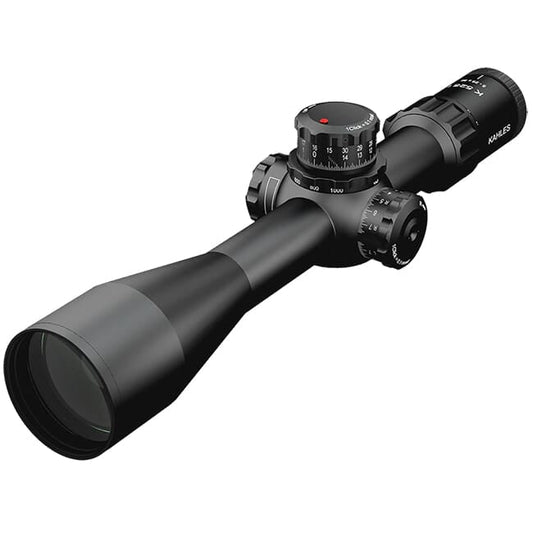

Kahles K525i 5-25x56 CCW rifle scope delivers precise optical performance with its first focal plane design, allowing for accurate reticle subtensions across all magnification levels. The illuminated reticle enhances visibility in varying light conditions, providing a clear sight picture for both tactical and competitive shooting. With options for left and right side windage adjustments, this scope accommodates all shooter preferences, ensuring quick and easy modifications without compromising your stance.
Built with a robust construction, the K525i withstands challenging environments, making it reliable in the field. The patented Twist Guard feature prevents accidental loss of zero, while .25 MOA adjustments enable precise corrections for improved accuracy. Weighing in at 34.2 oz and featuring a generous 3.74-inch eye relief, this scope is designed for comfort during extended sessions, whether you're hunting or competing.
Features:
- ENHANCED CLARITY for clear target acquisition in low light scenarios.
- INTUITIVE CONTROLS allow seamless adjustments without breaking your shooting stance.
- LEFT/RIGHT HAND FRIENDLY with LSW and RSW options for all shooter preferences.
- ILLUMINATED RETICLE enhances visibility and accuracy in various lighting conditions.
- PATENTED TWIST GUARD prevents accidental zero loss while allowing quick adjustments.
- RUGGED CONSTRUCTION ensures longevity and reliability in harsh environments.
- PRECISE ADJUSTMENTS with .1 MRAD or .25 MOA impact correction for accuracy.
- ZERO STOP TECHNOLOGY simplifies return-to-zero after adjustments for consistent shooting.
Technical Specifications Table
| Specification | Details |
|---|---|
| SKU | 10645-Kahles |
| Magnification Range | 5-25x |
| Objective Diameter | 56mm |
| Weight | 34.2 oz. |
| Exit Pupil | 9.5 - 2.3 mm |
| Field of View | 21.3' - 4.5' @ 100 yds |
| Eye Relief | 3.74" |
| Reticle Position | First Focal Plane |
| Scope Length | 14.8" |
| Scope Tube Size | 34 mm |
| Turret Adjustment | 104.4 / 46.8 (inches @ 100 yds) |
What’s in the Box?
- Lens covers
- Padded case
- Instruction manual
Customer Reviews
"The clarity in low light is simply unbeatable!" - Alex J.
"Perfect ergonomics and the windage adjustments are so smooth!" - Jenna R.
FAQ
How does the K525i perform in low light conditions?
With its high-definition optics and illuminated reticle, the K525i provides exceptional visibility, making it ideal for dawn or dusk shooting.
What is the difference between LSW and RSW models?
The LSW model is designed for right-handed shooters, while the RSW caters to left-handed shooters, allowing easy access to adjustments from different shooting positions.
How do I maintain the K525i for optimal performance?
Regularly clean the lenses with a soft cloth and store the scope in a protective case. Avoid exposing it to extreme conditions for extended periods.
Can the K525i be used for competitive shooting?
Yes, its precise adjustments and illuminated reticle make it suitable for various competitive shooting scenarios, ensuring you stay on target.
How does the K525i compare to other scopes in its class?
Compared to similar models, the K525i offers superior optical quality, ergonomic design, and advanced features like Twist Guard and Zero Stop technology.
Similar Models
If you're exploring more incredible optics, check out the rest of the Kahles collection. Discover models like the Kahles K318i for compact versatility or the Kahles K624i for even higher magnification options. Explore our full collection today to find the perfect scope tailored to your shooting adventures!
You May Also Like
Here’s some of our most similar products people are buying. Click to discover trending style.










